



Excellent and certainly provocative... If nothing else, the film is a real conversation starter.
View MoreThis film is so real. It treats its characters with so much care and sensitivity.
View MoreThe movie is made so realistic it has a lot of that WoW feeling at the right moments and never tooo over the top. the suspense is done so well and the emotion is felt. Very well put together with the music and all.
View MoreGreat example of an old-fashioned, pure-at-heart escapist event movie that doesn't pretend to be anything that it's not and has boat loads of fun being its own ludicrous self.
View MoreHaving just watched San Andreas-where the Golden Gate bridge was depicted as being shaken and falling in debris-it was nice to see it very much intact in this James A. FitzPatrick travelogue short. We also see the Oakland Toll bridge as Fitzpatrick mentions its cost and it being completed in 1936. We also see some churches built by some missionaries in the 18th century as the narrator mentions the city's name being inspired by Saint Francis. And then, we see some highlights of SF's World's Fair as there are reenactments of the pioneer settlers going west for gold, the Wells Fargo stage coaches, the final spike hammered in starting a new railroad line, and the Union and Central Pacific trains meeting. This was a nice look at San Fran during the early '40s. So on that note, Cavalcade of San Francisco is worth a look. P.S. I saw this as an extra on the Go West/The Big Store DVD disc.
View MoreCavalcade of San Francisco (1940) ** (out of 4)Weaker entry in James A. FitzPatrick's TravelTalks series takes a look at San Francisco and starts off by looking at the Oakland Bay Toll Bridge, which we're told took $77 million to complete. From here we get a great look at the Golden Gate Bridge and then it's off to various Old West things like seeing the Wells Fargo stagecoach, the Iron Horse train and several re-enactments. Also on hand is some footage from the World's Fair aka Treasure Island. Overall this entry isn't too bad but I just felt that we really didn't get to see San Francisco all that much and instead we were just watching local re-enactments. The stuff dealing with the Treasure Island World Fair was somewhat useless because there were two previous TravelTalks shorts that looked at it. Overall, this is certainly worth checking out if you're a fan of the series but it doesn't offer anything overly special.
View MoreAnother of the easy-to-take Fitzpatrick travelogues. This one I find most interesting in it's second half. The film has the great photography and film stock that we expect from Fitzpatrick, as he tells the story of the city of San Francisco from it's first appearance as a mission in 1769 to the modern day of 1940. The Oakland Bridge and the Golden Gate Bridge are both shown. So is the only building left over from the 1915 World's Fair. Then it concentrates on the Treasure Island World's Fair of 1939-40, and the cavalcade of American Expansion showing such events as the pioneers in their cover wagons, the Wells Fargo Stagecoachs, the laying of the Golden Spike at Promintory Point, Utah in 1869, and San Francisco in the gay 1890s. As a record of a long forgotten World's Fair attraction it is fascinating to look at. Oddly though, the most famous event in the city's history is not mentioned: it's determined rebuilding after the 1906 earthquake and fire. But then earthquakes are not good for tourism, and this travelogue was to encourage tourism.
View MoreThis is a colorful James A. FitzPatrick TravelTalk featuring a look at San Francisco (circa 1940), with views of several landmarks, including the Oakland Bay Toll Bridge completed in 1936 at a cost of $77 million and a gateway to Northern California; glimpse of a 1769 Spanish mission built by the Franciscan Fathers; a stunning view of the Golden Gate Bridge, the world's longest single span bridge; and culminating in scenes from a World's Fair exposition in 1939 that was a cavalcade of the Golden West.The pageantry includes covered wagons showing pioneers from the east making their way westward in caravans with nothing more than faith in the potential of the Golden West; the Wells Fargo stagecoach establishing contact between east and west; the advent of the Iron Horse and the meeting of the Union Pacific with Central Pacific; and finally, views of San Francisco at the turn of the 19th century.Summing up: Well done documentary with many points of interest.
View More